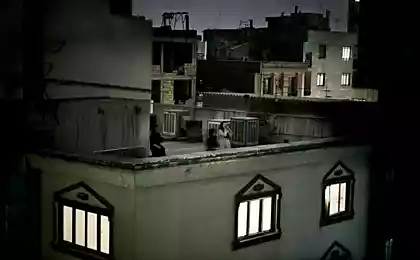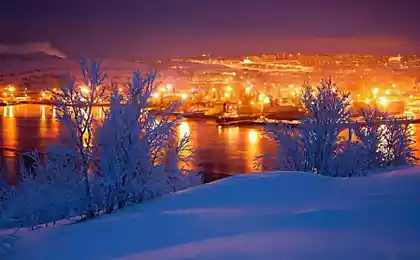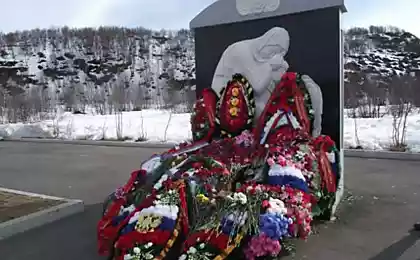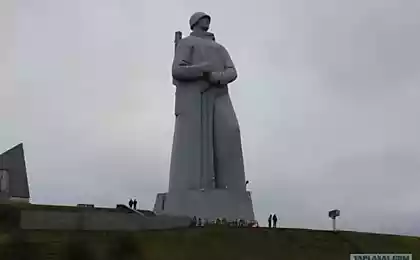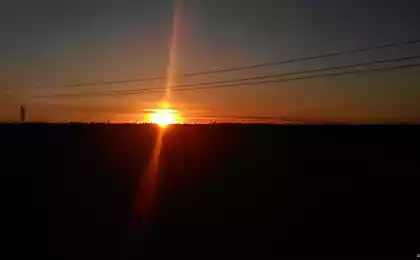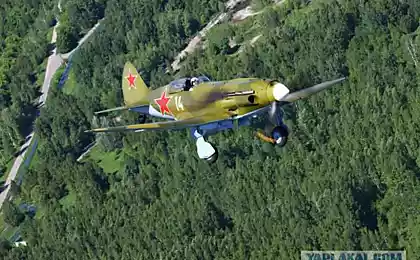1004
The Russian Arctic Circle
The whole village of yarangas belonging Nenets herders, is in the Arctic tundra in the Nenets Autonomous District. Nenets - the indigenous inhabitants of the Russian part of the Arctic Circle. They lived here before the Soviet collectivization and long before the pressure from oil and gas companies.
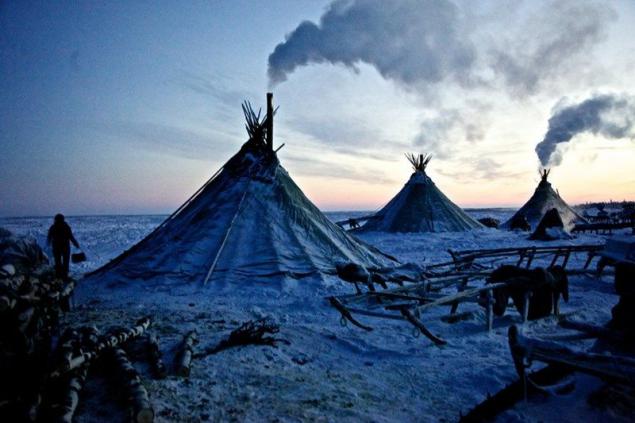
Operating one of the camps and gas companies carry hot water in residential areas. Water is heated in a tank with diesel fuel via
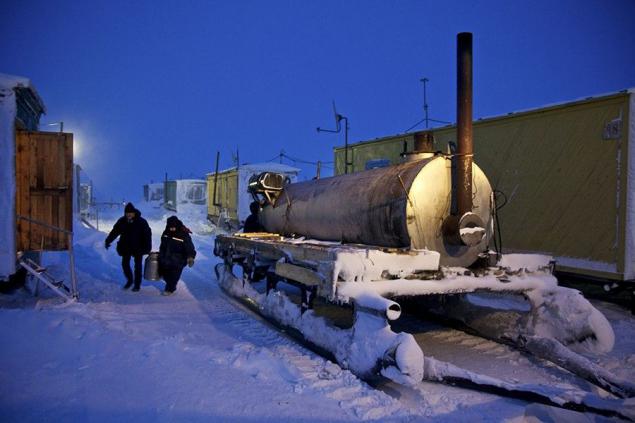
Workers inspect drilling unit with cleaning gas in Kumzhinskoe gas field, located in the delta of the Pechora River, 60 km from Naryan-Mar. In 1979, an explosion in one of wells led to the emergence of uncontrolled gas blowout and its condensate contaminated vast areas of the nearby tundra, including the Pechora River. May 25, 1981 the authorities tried to fill the field with the help of an underground nuclear explosion at a depth of 1470 m. The blast led to more pollution. After this area was closed and made a reservation. In recent years, gas has become even more here. In 2007, Putin signed a decree on deprivation of the status of the territory of the reserve, to continue here gazorazrabotku.
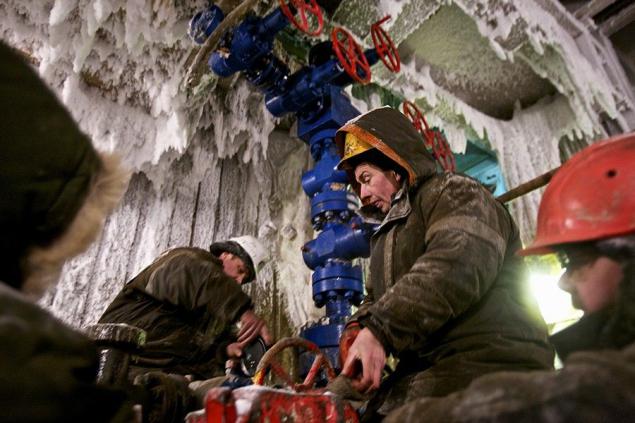
Nenets reindeer herder collects herd at 40-degree frost. Shepherds sit on reindeer meat processing plants, and horns are sold to China, where they are widely used in traditional medicine, including as an aphrodisiac.
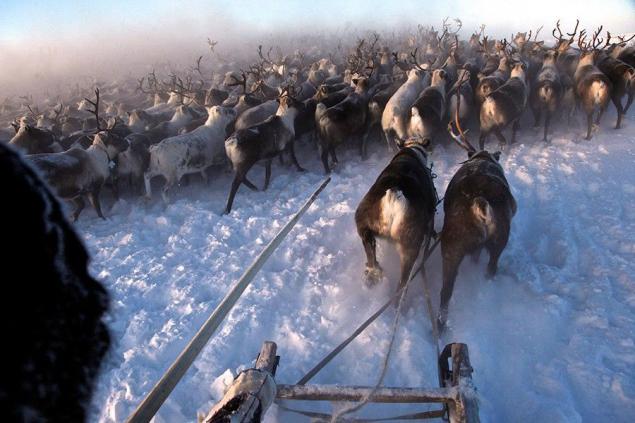
The city of Naryan-Mar, Nenets Autonomous District, people live in yurts in the cold at -40.
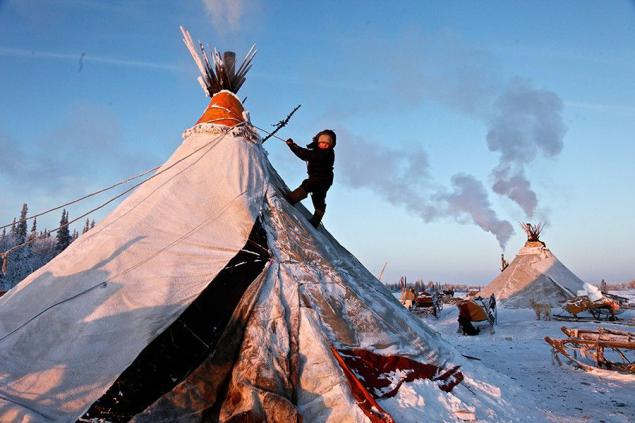
Their main source of food and income - herding.
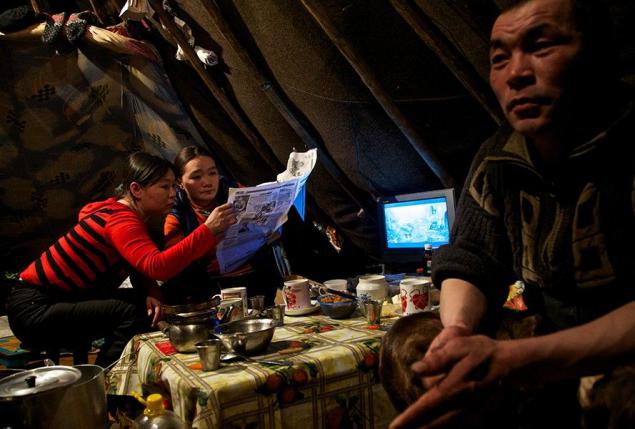
The family gathered around the TV to see the news release.

Shepherds Semen and Ivan a few hours riding on a sleigh from his yurt in the tundra to buy products at the store of the village Soviet. In these nomadic peoples, they are mutually wary relationship with Russian living in the Far East. Vorkuta - coal-mining town, a former part of the Gulag, it is 1931 km north-east of Moscow, in the Arctic Circle. In winter the temperature drops to -50 here. The region is slowly emptying entire villages and buried in snow, and the financial crisis pressed coal mining companies, which already can not find workers. Moscow says that the Far East - an important strategic area in which to invest in the oil and gas production. But that's the paradox: the Far East almost extinct. Every year thousands of people from the cities of the Russian Far North are fleeing further south. The system of subsidies that supported Siberia and the Arctic Circle in the Soviet era, collapsed. Now the advantages of living in the Far North is not - pay is not higher than in Central Russia, but food prices are several times higher.
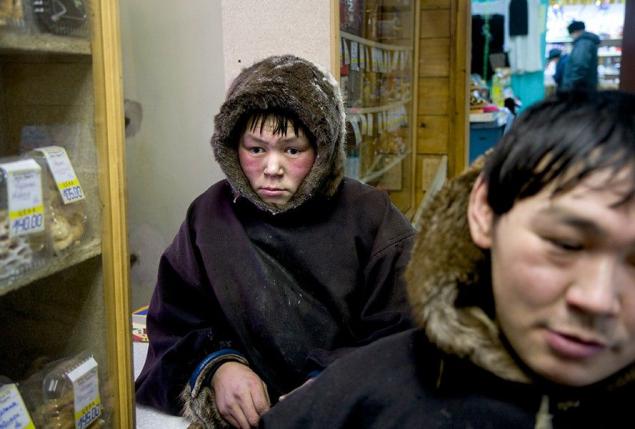
Semen few hours riding on a sled to a nearby store to his yurt in the village Soviet. Construction of gas pipes in the tundra is threatening the traditional way of life of local herdsmen, forcing them to go farther and farther to the north in search of places to reindeer pastures.

70-year-old Philip Andreev and his 68-year-old wife Angelina born in the tundra, but their families were forced to move to the city during the Soviet collectivization. But some traditions do not die. In this photo, they cut up the carcass of a reindeer.
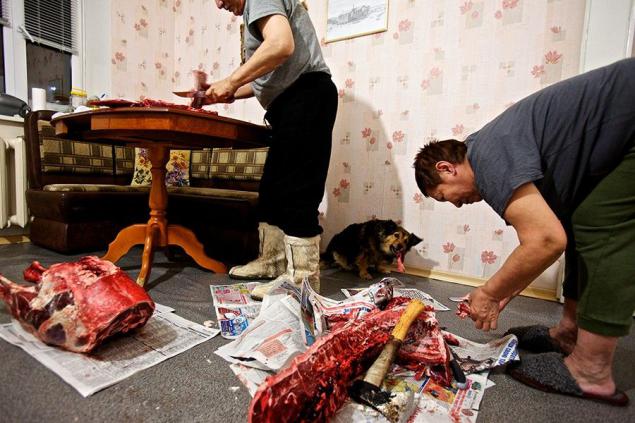
Monument to the Great Patriotic War against the backdrop of Murmansk - the largest city in the Arctic Circle, and one of the largest industrial cities and ports of Russia. This city was an important military base during the Cold War with Finland and Norway.
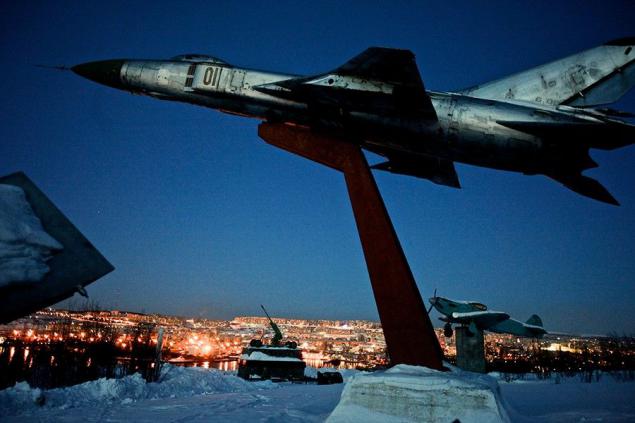
Shakhtar Carp Belgaev in Yor Shor - abandoned village near Vorkuta. He - one of the last ten villagers. Miners say that, having worked for 10 years under the ground, remove the black "eyeliner" with the eye of coal dust is virtually impossible.
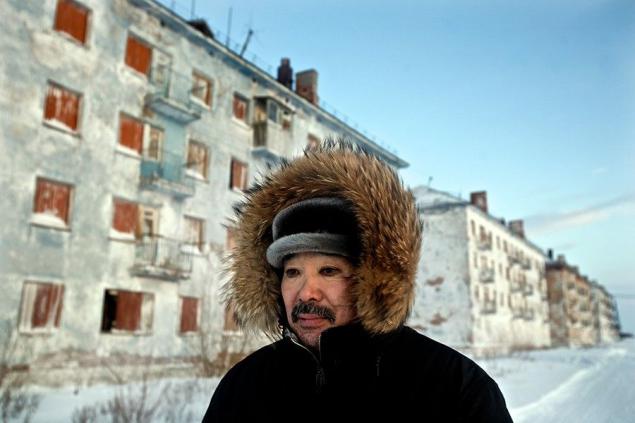
Alexander Kraszewski looks much older, his 35 years. Alcoholics - one of the few who survive in the polar cities as they can. Most residents left for the south in search of work. The local population is declining rapidly, and the rest quickly become an inveterate drunkard.

Emissions that exude that the nickel plant, kills virtually all vegetation within a radius of 5 km. The plant, built in 1937, produces five times more sulfur dioxide than all of Norway, which is just 7 km away. In 2001, Norway has the company "Norilsk Nickel" 32 million euros to modernize the plant to reduce pollution levels. The money disappeared, the pollution continues.
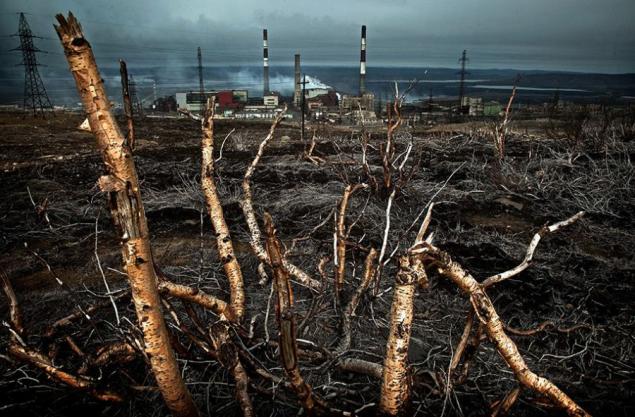
A dense pall of emissions from the nickel plant hangs over the city of Nikel. The contained sulfur angedrid kills vegetation, pollute groundwater and is the source of the development of asthma, especially in children.
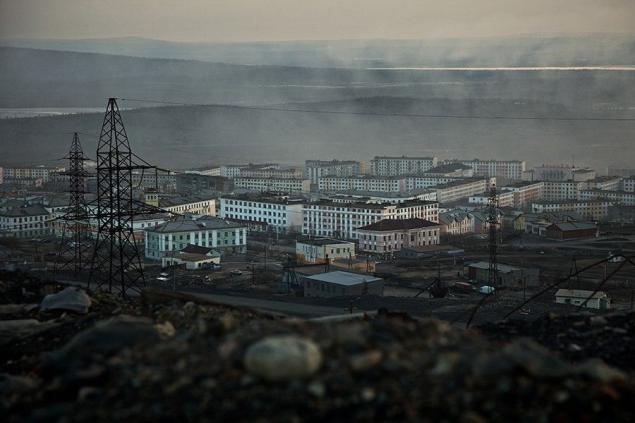
The girls are on the hot water pipe in the city adjacent to the Polar Nickel.
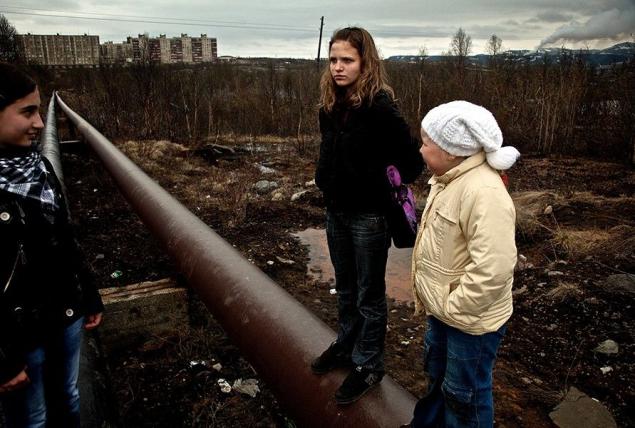
Valery Zhukov, married a miner and a trade union representative in the village of North, near Vorkuta, dancing with his mistress Lena, who lives in the same area. The one sitting - his friend Alexander.
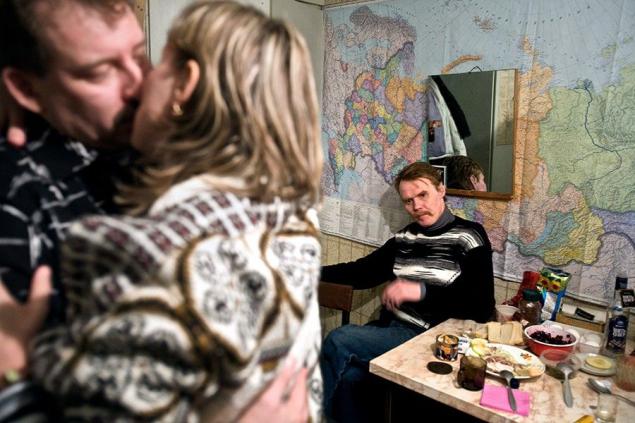
Valery Zhukov and his mistress Lena. Valery, a miner from the town of North, has a wife and daughter.

Miners smoked under the sign "No smoking" after the change in the North Mine - one of the five that are still running around Vorkuta. 10 years ago there were 13. The average life expectancy of a miner in the Far East - 54 years, but many die before they reach up to 50.
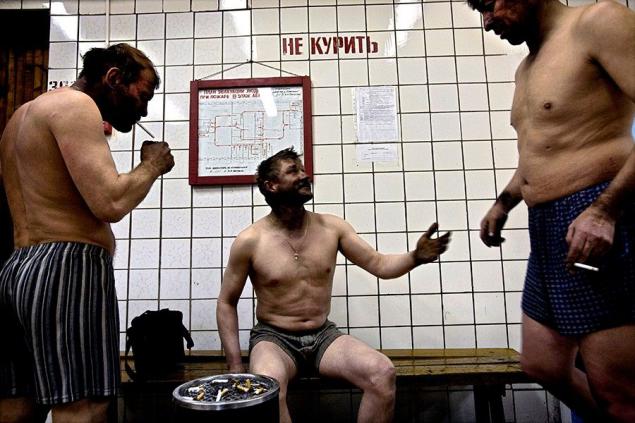
Work of "Lukoil" repairing a leak in Komi region, home to some of the largest gas fields in the world.
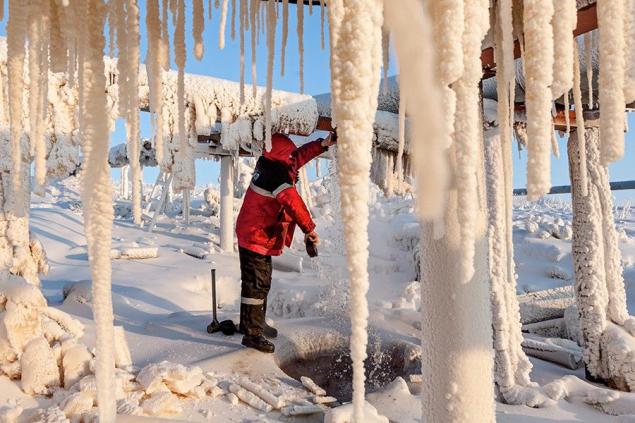
Work wiping the snow after a sauna. Water is heated in a tank with diesel fuel (left). Typically, these people are working in isolation in the cold all winter. They return to civilization only in the spring.
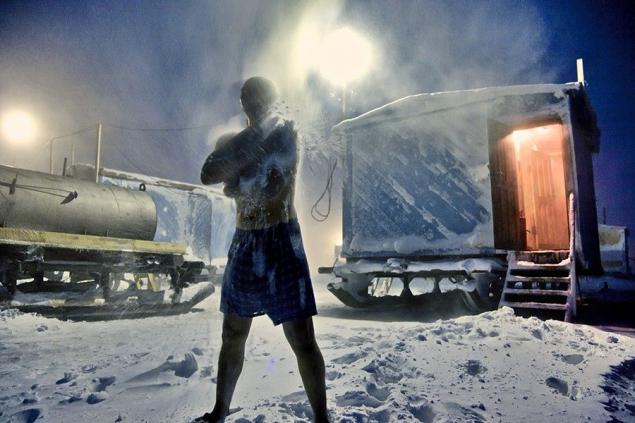
Workers Oil and Gas Company "Basheft" in the smoking room.
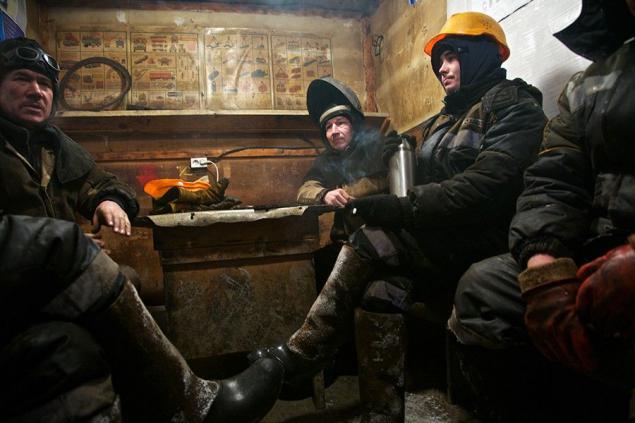
Each winter, workers build ice and snow roads in the tundra, it was easier to get to the oil and gas companies. And every year the roads melt and turn into swamps.
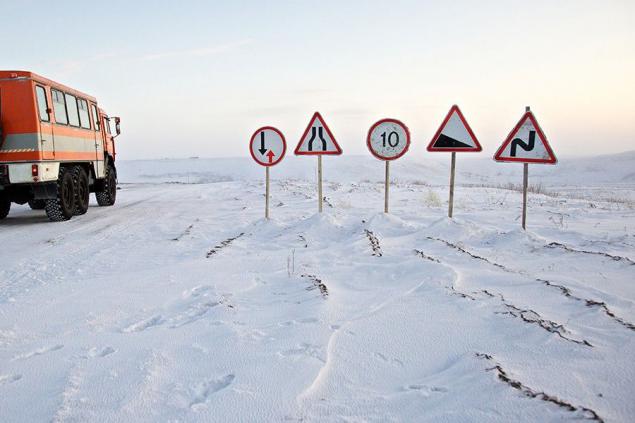

Operating one of the camps and gas companies carry hot water in residential areas. Water is heated in a tank with diesel fuel via

Workers inspect drilling unit with cleaning gas in Kumzhinskoe gas field, located in the delta of the Pechora River, 60 km from Naryan-Mar. In 1979, an explosion in one of wells led to the emergence of uncontrolled gas blowout and its condensate contaminated vast areas of the nearby tundra, including the Pechora River. May 25, 1981 the authorities tried to fill the field with the help of an underground nuclear explosion at a depth of 1470 m. The blast led to more pollution. After this area was closed and made a reservation. In recent years, gas has become even more here. In 2007, Putin signed a decree on deprivation of the status of the territory of the reserve, to continue here gazorazrabotku.

Nenets reindeer herder collects herd at 40-degree frost. Shepherds sit on reindeer meat processing plants, and horns are sold to China, where they are widely used in traditional medicine, including as an aphrodisiac.

The city of Naryan-Mar, Nenets Autonomous District, people live in yurts in the cold at -40.

Their main source of food and income - herding.

The family gathered around the TV to see the news release.

Shepherds Semen and Ivan a few hours riding on a sleigh from his yurt in the tundra to buy products at the store of the village Soviet. In these nomadic peoples, they are mutually wary relationship with Russian living in the Far East. Vorkuta - coal-mining town, a former part of the Gulag, it is 1931 km north-east of Moscow, in the Arctic Circle. In winter the temperature drops to -50 here. The region is slowly emptying entire villages and buried in snow, and the financial crisis pressed coal mining companies, which already can not find workers. Moscow says that the Far East - an important strategic area in which to invest in the oil and gas production. But that's the paradox: the Far East almost extinct. Every year thousands of people from the cities of the Russian Far North are fleeing further south. The system of subsidies that supported Siberia and the Arctic Circle in the Soviet era, collapsed. Now the advantages of living in the Far North is not - pay is not higher than in Central Russia, but food prices are several times higher.

Semen few hours riding on a sled to a nearby store to his yurt in the village Soviet. Construction of gas pipes in the tundra is threatening the traditional way of life of local herdsmen, forcing them to go farther and farther to the north in search of places to reindeer pastures.

70-year-old Philip Andreev and his 68-year-old wife Angelina born in the tundra, but their families were forced to move to the city during the Soviet collectivization. But some traditions do not die. In this photo, they cut up the carcass of a reindeer.

Monument to the Great Patriotic War against the backdrop of Murmansk - the largest city in the Arctic Circle, and one of the largest industrial cities and ports of Russia. This city was an important military base during the Cold War with Finland and Norway.

Shakhtar Carp Belgaev in Yor Shor - abandoned village near Vorkuta. He - one of the last ten villagers. Miners say that, having worked for 10 years under the ground, remove the black "eyeliner" with the eye of coal dust is virtually impossible.

Alexander Kraszewski looks much older, his 35 years. Alcoholics - one of the few who survive in the polar cities as they can. Most residents left for the south in search of work. The local population is declining rapidly, and the rest quickly become an inveterate drunkard.

Emissions that exude that the nickel plant, kills virtually all vegetation within a radius of 5 km. The plant, built in 1937, produces five times more sulfur dioxide than all of Norway, which is just 7 km away. In 2001, Norway has the company "Norilsk Nickel" 32 million euros to modernize the plant to reduce pollution levels. The money disappeared, the pollution continues.

A dense pall of emissions from the nickel plant hangs over the city of Nikel. The contained sulfur angedrid kills vegetation, pollute groundwater and is the source of the development of asthma, especially in children.

The girls are on the hot water pipe in the city adjacent to the Polar Nickel.

Valery Zhukov, married a miner and a trade union representative in the village of North, near Vorkuta, dancing with his mistress Lena, who lives in the same area. The one sitting - his friend Alexander.

Valery Zhukov and his mistress Lena. Valery, a miner from the town of North, has a wife and daughter.

Miners smoked under the sign "No smoking" after the change in the North Mine - one of the five that are still running around Vorkuta. 10 years ago there were 13. The average life expectancy of a miner in the Far East - 54 years, but many die before they reach up to 50.

Work of "Lukoil" repairing a leak in Komi region, home to some of the largest gas fields in the world.

Work wiping the snow after a sauna. Water is heated in a tank with diesel fuel (left). Typically, these people are working in isolation in the cold all winter. They return to civilization only in the spring.

Workers Oil and Gas Company "Basheft" in the smoking room.

Each winter, workers build ice and snow roads in the tundra, it was easier to get to the oil and gas companies. And every year the roads melt and turn into swamps.

